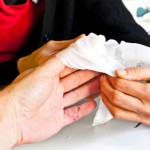 One of the dreadful things a PT/PTA student encounters during clinicals is to provide an inservice in the facility he or she rotates. As a clinical instructor, I have personally seen my students undergo this grueling task successfully and otherwise. The stress of speaking in front of accomplished professionals only adds to the burden of having to work in the real-world clinical setting.
One of the dreadful things a PT/PTA student encounters during clinicals is to provide an inservice in the facility he or she rotates. As a clinical instructor, I have personally seen my students undergo this grueling task successfully and otherwise. The stress of speaking in front of accomplished professionals only adds to the burden of having to work in the real-world clinical setting.
Let’s face it, not all of us were born public speakers. Public speaking is built on the foundation of self-confidence and experience. However, there is hope for those who are not naturals in this area. After all, it’s not just about the accolades, it’s also about getting high grades.
Here are a few tips to become an effective PT/PTA speaker:
1. Choose a topic that interests the therapists in the facility and provide current information.
A one-sided fault for students is to focus on their topic of interest and failing to align with the common interest of the facility staff. My recent student actually chose a topic on how nerve blocks affect total knee replacement surgeries. This was a great move and an interesting topic for most acute physical therapists in our department who handle these patients on a daily basis. Not only was the topic trending in the field of knee replacements, but also it encourages the student to do research on more current data (studies, medical articles, journals, etc.) on its effectiveness based on evidence-based practice.
2. Share the enthusiasm and passion.
To project enthusiasm and passion on the subject, the student must know the topic from the heart. A student achieves this by having the interest and desire to share the knowledge. Preparation of the material and good research skills are very important to accomplish the task.
3. Capture audience attention by appropriate movement.
Let’s take the late Steve Jobs as a good example of a great public speaker. In his talks, he does calculated moves while on stage. He uses his hands to power up his words. But he also controls his tone of voice and gestures when he wants to emphasize something. In other words, students should try to move around to get everybody’s attention, and eye contact is key. Holding on to index cards may be acceptable as long as they’re small enough for you to provide occasional hand gestures. Remember, body language gets magnified when you’re in front of an audience. If a student has shaky hands, they can hide them once in a while in his or her pockets or make a fist and place them behind the back while talking.
4. Encourage Question and Answer portion.
I always suggest to my students to encourage question and answer at the end of the inservice. This usually portrays an image of confidence to the speaker that he or she can take on a challenge. If questions are answered, then great! But if it’s a difficult question, it is always fine to be honest about it and maybe even bounce it back to the audience. After all, you are the student and they are the licensed professionals.
5. Project professionalism.
Lastly, act and look the part. In terms of delivering the inservice, avoid reading word for word on paper or onscreen. To be treated as a professional, the student should provide clear, organized, concise handouts and visuals to support the inservice. It doesn’t have to be expensive, fancy or state-of-the-art.







